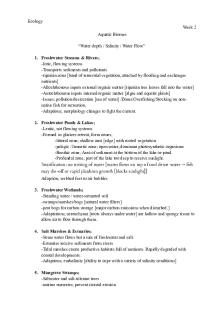Week 2 Epistles - Lecture notes 2 PDF

| Title | Week 2 Epistles - Lecture notes 2 |
|---|---|
| Author | LAUREN MB |
| Course | Critical Reading 2 |
| Institution | Bath Spa University |
| Pages | 2 |
| File Size | 86 KB |
| File Type | |
| Total Downloads | 78 |
| Total Views | 139 |
Summary
Lecture / seminar notes...
Description
Week 2: ‘An Epistle to a Lady’ and ‘An Epistle to Burlington’
Read the poems, and explore eigtheenth-century ideas of gender by researching materials available from BSU Online library, such as Defining Gender 1450-1900, Eighteenth Century Collections Online and Eighteenth Century Journals Online. Please look over these databases and find one short quotation concerning eighteenth-century gender norms. Please be prepared to discuss this quotation AND the way in which you went about this search in terms of keywords, etc. What might be the challenges and benefits of these databases? ‘An Epistle to a Lady’ 1. What is meant by ‘Most women have no characters at all’? Consider the individual portraits of the women in ll. 21-180. 2. How does the poem juxtapose masculine and feminine qualities? Look carefully at ll. 199218. 3. How does Pope’s friend Martha Blount, to whom the poem is dedicated, differ from the other women depicted in the poem? What qualities does she possess? Pay particular attention to ll. 249-280. 4. ‘Like every satire on women, [‘Epistle to a Lady’] is shaped by stereotypes: women are fickle, frail, and subordinate to men. Yet much of the poem undermines those prejudices by showing the real difficulties of women’s lives. “By man’s oppression cursed,” they waste their talents on trivial pursuits and “die of nothing but a rage to live.” The poem shares that restlessness. If women are full of contradictions, so are Pope’s couplets, torn between sympathy and satiric bite. The poet finds himself strangely attracted to what he disapproves, and many female readers, then and now, have felt the same way about the poem.’ The Norton Anthology of English Literature, Volume C: The Restoration and The Eighteenth Century, 10th edn., ed. by James Noggle (New York & London: Norton, 2018), p. 643. Do you agree? What examples of contradiction or tension can you find in Pope’s representation of women in the poem? ‘An Epistle to Burlington’ 1. How the poem exemplify and satirise bad taste? In addition to the opening of the poem, you should pay specific attention to the ‘Timon’ section (ll. 101-168) 2. How does Pope characterise good taste? What examples does he give? 3. What kinds of attitudes to riches does the poem satirise? What is the ‘correct’ use of riches? Consider the description of the model landowner in ll. 173-190 and the moralising section that follows it.
1
Finally, answer question 4 or 5, according to your theoretical interests: 4. ‘Both of Pope’s Epistles on the use of riches [‘Bathurst’ and ‘Burlington’] are ferocious attacks on the misuse of wealth, but paradoxically (and protectively and provocatively) addressed to two of the wealthiest men in the country. The corruption he depicts is extreme. From the Court downwards the aristocracy is debauched by the pursuit of power, place and pecuniary greed, poxed by promiscuity, a High Society of pimps and gamesters, flatters and fools.’ Malcolm Kelsall, ‘Landscapes and Estates’, in The Cambridge Companion to Alexander Pope, ed. by Pat Rogers (Cambridge: Cambridge University Press, 2007), pp. 161-174 (p. 169). How do you read the class politics of the poem in light of this quotation? 5. Look carefully at the representation of nature and the landscape. How does Pope describe nature? How does it relate to morality and virtue? Study group task: The poem is dedicated to Richard Boyle, Earl of Burlington. Who was Burlington? How does the dedication to him reflect the major themes of the poem?
2...
Similar Free PDFs

WEEK 2 - Lecture notes 2
- 5 Pages

Week 2 - Lecture notes 2
- 7 Pages

Week 2 Lecture Notes
- 5 Pages

Week Two - Lecture notes 2
- 9 Pages

Lecture Notes Week 2 1014CCJ
- 7 Pages

WEEK 2 ACCY112 - Lecture notes 2
- 3 Pages

NSE 13 week 2 - Lecture notes 2
- 5 Pages

NURS10016 - Week 2 - Lecture notes 2
- 22 Pages
Popular Institutions
- Tinajero National High School - Annex
- Politeknik Caltex Riau
- Yokohama City University
- SGT University
- University of Al-Qadisiyah
- Divine Word College of Vigan
- Techniek College Rotterdam
- Universidade de Santiago
- Universiti Teknologi MARA Cawangan Johor Kampus Pasir Gudang
- Poltekkes Kemenkes Yogyakarta
- Baguio City National High School
- Colegio san marcos
- preparatoria uno
- Centro de Bachillerato Tecnológico Industrial y de Servicios No. 107
- Dalian Maritime University
- Quang Trung Secondary School
- Colegio Tecnológico en Informática
- Corporación Regional de Educación Superior
- Grupo CEDVA
- Dar Al Uloom University
- Centro de Estudios Preuniversitarios de la Universidad Nacional de Ingeniería
- 上智大学
- Aakash International School, Nuna Majara
- San Felipe Neri Catholic School
- Kang Chiao International School - New Taipei City
- Misamis Occidental National High School
- Institución Educativa Escuela Normal Juan Ladrilleros
- Kolehiyo ng Pantukan
- Batanes State College
- Instituto Continental
- Sekolah Menengah Kejuruan Kesehatan Kaltara (Tarakan)
- Colegio de La Inmaculada Concepcion - Cebu







